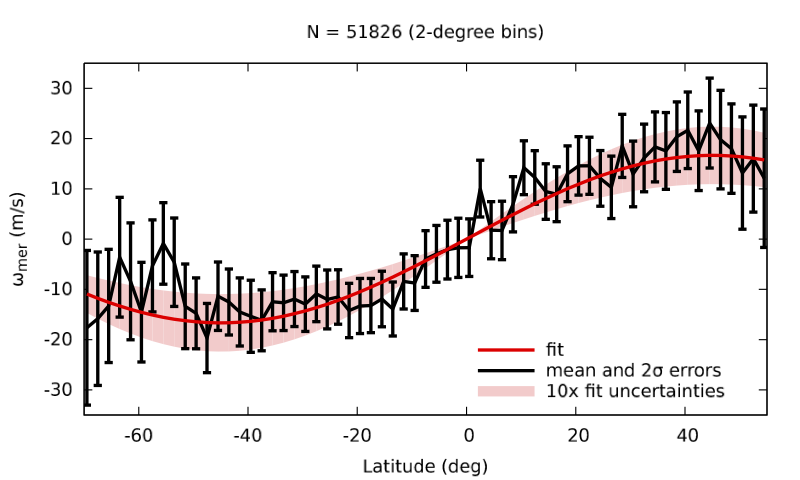Derek A. Lamb
Southwest Research Institute, Boulder, CO 80020, USA
Long-lived photospheric flows are important drivers and diagnostics of the dynamo that is responsible for the solar cycle. Both the rotational and the meridional flows are now thought to be direct consequences of the convection that occurs in the outer ~30% of the Sun by radius. Both of these flows vary with latitude, depth, and time, and also vary among the various methods used to measure them. One method of measuring flows on the surface has been through the motions of patterns of magnetic features. This typically requires dividing the solar surface into “patches,” and correlating the motion of the patches over some long time interval. I present a new method based on measuring the motions of individual features in a long time series of high cadence magnetograms1.
I used SDO/HMI line-of-sight magnetograms from nearly the entire month of February 2011, at a cadence of 12 minutes. I processed reduced-resolution versions of the magnetograms with the Southwest Automatic Magnetic Identification Suite (SWAMIS) feature tracking code. SWAMIS identifies magnetic features on the solar surface and associates them across multiple images. Magnetic features are regions of the solar surface, grouped into collections of adjacent pixels that all have a pixel-averaged field strength above a certain low threshold, and that have at least one pixel above a certain high threshold at some point in time. This version of the code makes no a priori assumptions about the solar rotation rate, requiring instead that a given feature occupy approximately the same image pixels in consecutive magnetograms. Thus the cadence and resolution of the data must be well-matched to the known ~14 deg d-1 equatorial rotation rate. Only the portion of the solar surface within 60 heliographic degrees of disk center was analyzed, to reduce the line-of-sight and foreshortening effects.
Figure 1 | Differential rotation profile for photospheric magnetic features with lifetime greater than 10 hours. Shown is (black) the mean of the velocities in each 2-degree latitudinal bin and error bars representing twice the standard error of the mean, (red) the best fit to the mean, and (pink) 10 times the uncertainties in the fit.
With such high cadence over such a long period of time, nearly 8 × 106 features are tracked in the data. This allowed me to aggressively filter which features would be included in the analysis (controlling for perturbations due to short-lived flows and due to false motions from feature interactions) and effectively isolate the long-lived flows traced by the magnetic features. After this filtering, nearly 52,000 features remain. From these I produced high-fidelity differential rotation measurements with well-characterized variances and covariances of the fit parameters, and medium-fidelity measurements of the much weaker meridional flow that are broadly consistent with previous results.
I find a sidereal rotational profile (Fig. 1) of (14.296 ± 0.006) + (- 1.847 ± 0.056) sin2 b + (- 2.615 ± 0.093) sin4 b (b is latitude), with units of degree per day, and a large covariance σ2BC = – 4.87 × 103 deg2 d-2. The large σ2BC is due to the well-known cross talk between the second and third terms of the fitting equation. I find a meridional flow (Fig. 2) with a peak speed of 16.7 ± 0.6 m s-1 at latitude b = 45 deg; however, these data are insufficient for characterizing its high-latitude behavior.
Figure 3 | Comparison of differential rotation curves obtained from some published rotation coefficients, in which the middle rotation curve has been subtracted to emphasize the differences. The rotation curve found in this work from individual magnetic features1 (solid black line) is consistently slower than the coronal bright point curve3 (solid purple line). Surface spectroscopic observations (dashed lines in turquoise envelope) and surface tracer observations2 (dotted lines in orange envelope) are also plotted. References for comparison curves are available1.
A comparison of my measured sidereal rotational profile with the surface differential rotation from spectroscopic and photospheric surface tracer measurements2, as well as with recent coronal bright point measurements3 from SDO/AIA is shown in Fig. 3. My measured flow is slower than all three spectroscopic measurements for latitudes above 30 degrees, consistent with previous trends that the rotation rate measured by surface tracers is slower than the rotation rate measured spectroscopically. Of particular interest is the fact that the coronal bright points are measured to rotate faster than the photospheric magnetic features to which they are supposedly anchored. The peak meridional flow speeds derived from coronal bright points is also faster (~50%) than I measured with small magnetic features. A joint analysis on a common data set would be crucial to resolve this discrepancy now that analogous photospheric and coronal methods have been established.
References
[1] Lamb, D. A., 2017, ApJ, 836, 10
[2] Beck, J. G., 2000, SoPh, 191, 47
[3] Sudar, D., Saar, S. H., Skokić, I., Poljančić Beljan, I., & Brajša, R., 2016, A&A, 587, A29

